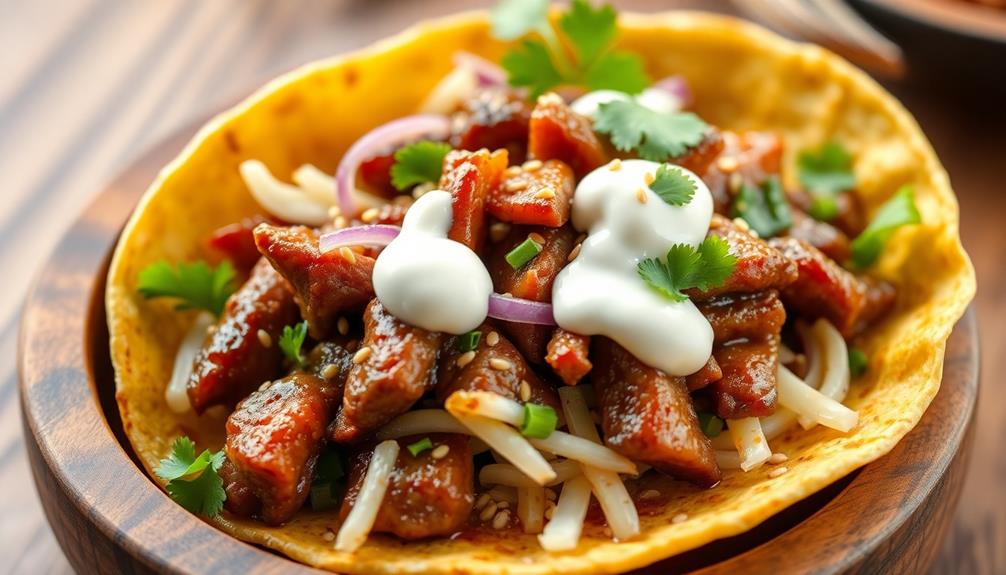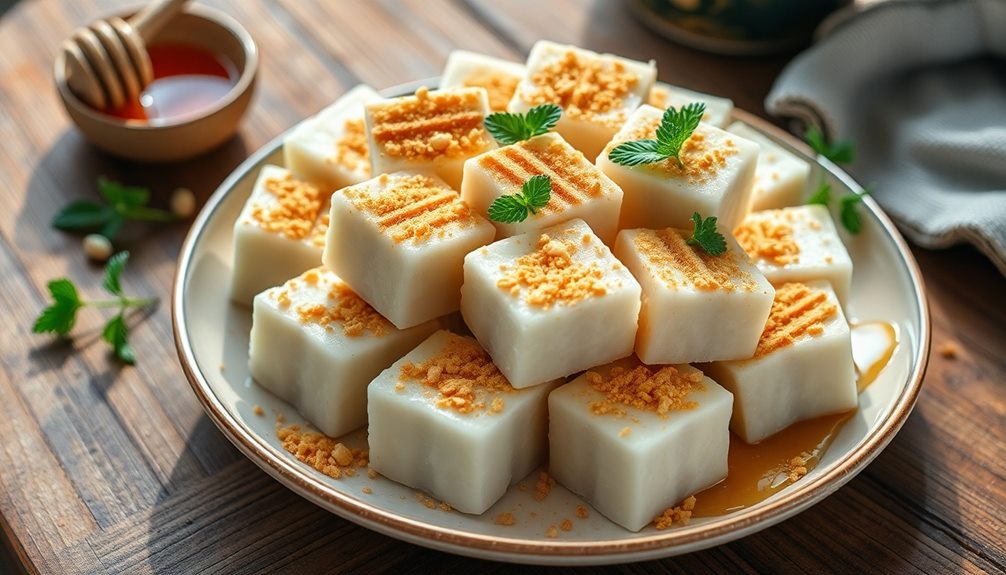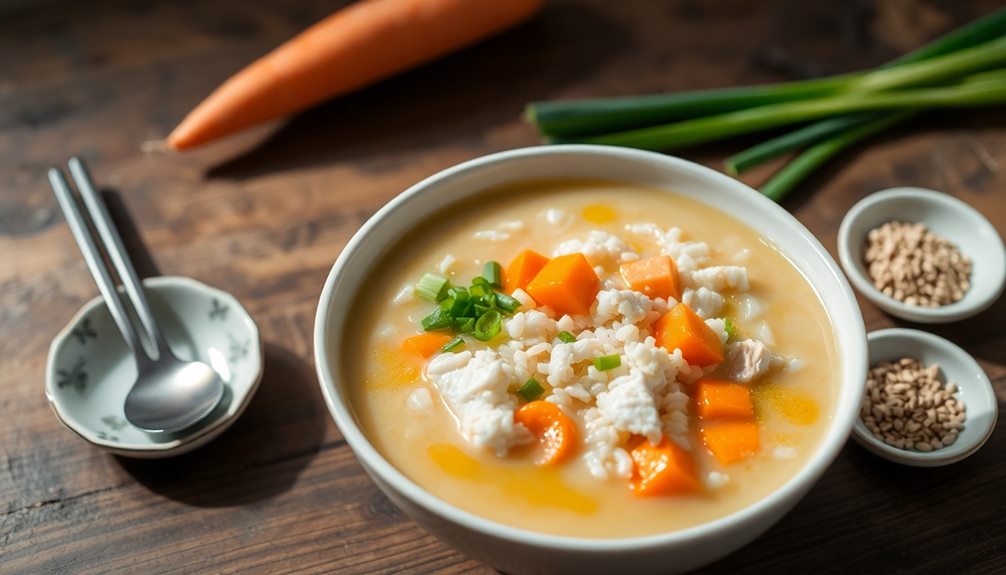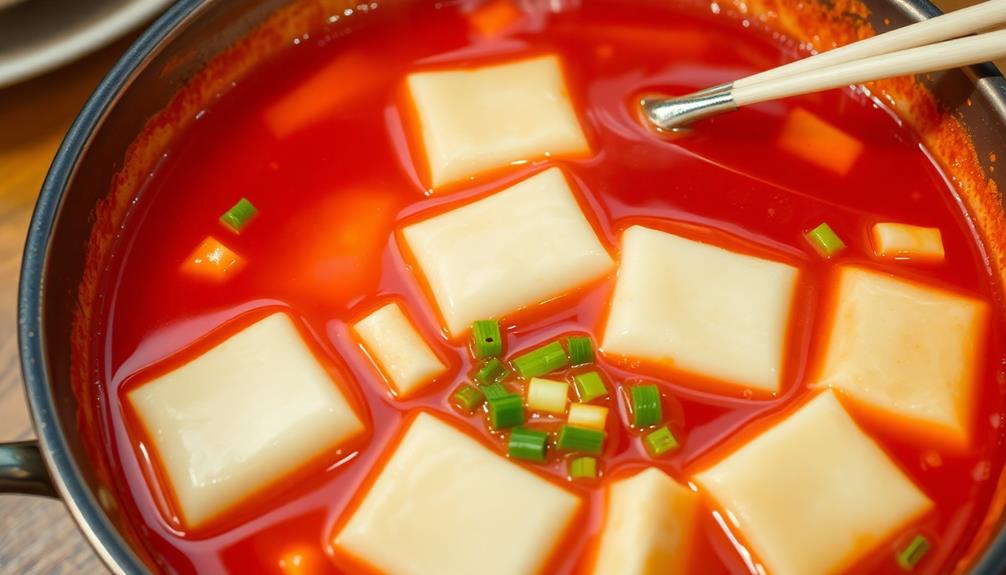Get ready to embark on a flavorful culinary journey as you explore the captivating blend of Korean and Mexican cuisines in the form of mouthwatering bulgogi tacos – a delightful street food sensation that's taking the world by storm! Discover the rich history of bulgogi, a beloved Korean dish fit for royalty, now infused with the zesty flavors of Mexico. Savor the tender, marinated beef, the warmth of soft tortillas, and the vibrant crunch of fresh veggies. Top it off with aromatic herbs and a drizzle of bold sauces for an explosion of taste in every bite. Prepare to be wowed by this unique fusion masterpiece!
Key Takeaways
- Bulgogi, a Korean marinated beef dish, has gained global popularity and inspired fusion creations like bulgogi tacos, blending Korean and Mexican cuisines.
- Key ingredients for bulgogi tacos include thinly sliced marinated beef, soft tortillas, fresh vegetables, and optional additions like sauces, cheese, and garnishes.
- The cooking process involves slicing the beef, marinating it in a flavorful soy-based mixture, grilling the meat, and assembling the tacos with the desired toppings.
- Bulgogi tacos offer a visually appealing presentation with vibrant colors and textures, creating an inviting and satisfying dining experience.
- The popularity of bulgogi tacos reflects the growing appreciation for fusion cuisine, cultural exchange, and the creativity in recipe development that transcends geographical boundaries.
History
Bulgogi, the beloved Korean dish of thinly sliced, marinated beef, has a rich history dating back centuries. This delectable dish was first enjoyed by the Korean royal family and eventually spread to the common people. Over time, bulgogi evolved into a popular staple at Korean barbecue gatherings, where it is often grilled to perfection and enjoyed with an array of side dishes. Alongside bulgogi, other dishes like the Korean squid and pork belly dish have also gained popularity, offering a variety of flavors and textures to the Korean dining experience. Together, these dishes showcase the versatility and depth of Korean cuisine.
Over time, the recipe has evolved, with variations in the marinade and cooking methods.
What's especially exciting is how bulgogi has recently made its way onto the global culinary stage, inspiring creative fusion dishes like bulgogi tacos! These tasty treats combine the savory flavors of bulgogi with the zesty, handheld convenience of tacos.
It's the perfect marriage of Korean and Mexican cuisines, blending cultures and satisfying taste buds everywhere.
As you bite into a bulgogi taco, you'll savor the tender beef, the tangy marinade, and the fresh crunch of the taco shell.
It's a delightful adventure for your senses, transporting you from the streets of Seoul to the vibrant food stalls of Mexico.
Get ready to embark on a flavorful journey with every bite!
Recipe
Bulgogi, the beloved Korean beef dish, takes on a delightful twist when transformed into tacos. This fusion of flavors creates a delightful and unique culinary experience that's sure to impress your taste buds.
The key to achieving the perfect Bulgogi Tacos lies in the balance of sweet, savory, and tangy elements. The tender, marinated beef is the star of the show, complemented by a range of vibrant toppings that add depth and complexity to the dish.
- Flank steak or ribeye, thinly sliced
- Soy sauce
- Brown sugar
- Garlic, minced
- Ginger, grated
- Sesame oil
- Vegetable oil
- Green onions, thinly sliced
- Flour tortillas or corn tortillas
- Shredded cabbage or lettuce
- Carrots, julienned
- Kimchi (optional)
- Sesame seeds (for garnish)
Begin by marinating the thinly sliced beef in a mixture of soy sauce, brown sugar, garlic, ginger, and sesame oil for at least 30 minutes, or up to 24 hours for maximum flavor.
Heat a large skillet or wok over high heat, add a drizzle of vegetable oil, and sauté the marinated beef until it's beautifully caramelized and cooked through. Remove the beef from the heat and toss with the sliced green onions.
To assemble the tacos, warm the tortillas and layer them with the saucy bulgogi, shredded cabbage or lettuce, julienned carrots, and a spoonful of kimchi, if desired.
Sprinkle with sesame seeds for a touch of nutty crunch. Serve immediately and enjoy the harmonious blend of flavors and textures in every bite.
Cooking Steps
First, you'll need to slice the beef into thin, uniform strips so it cooks quickly and evenly.
Next, you'll marinate the beef in a delightful bulgogi sauce, letting the flavors soak in.
Then, you'll grill the marinated beef over high heat, getting those perfect charred edges.
Time to assemble your tacos – layer the grilled beef, then top it all off with some fresh, fragrant cilantro.
Step 1. Slice Beef Into Thin Strips
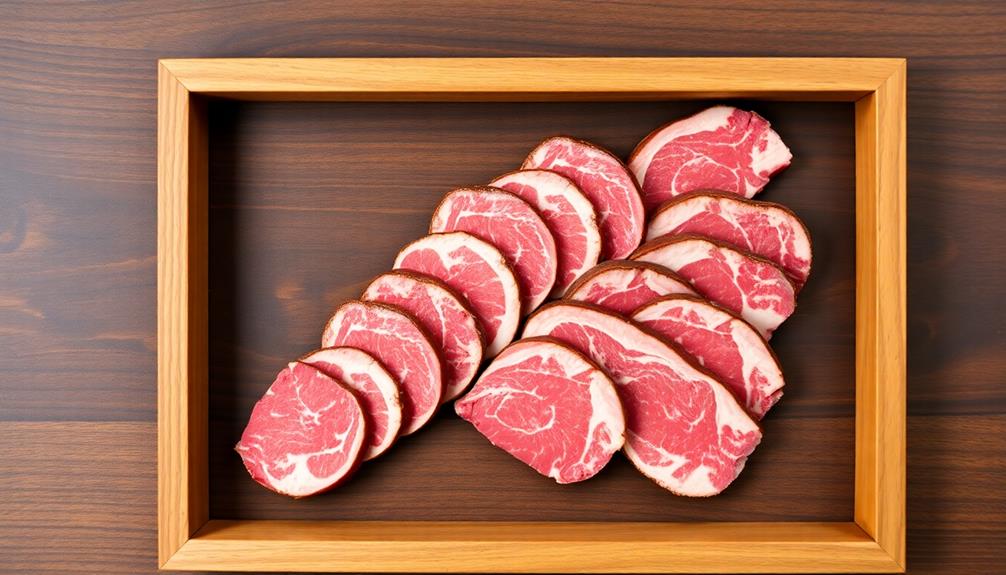
To begin the slicing process, take the beef and, with a sharp knife, carefully slice it into thin, uniform strips. You'll want to slice across the grain of the meat for the most tender texture. Go slowly and pay close attention – you don't want any uneven pieces!
Once you've got a nice pile of thin, evenly-sliced beef, you're ready for the next step.
The key is to slice the beef into strips that are around 1/4-inch thick. This will ensure the meat cooks quickly and becomes wonderfully tender and juicy.
As you slice, try to keep the strips around 2-3 inches long. This size is perfect for packing into the tacos without being too bulky or difficult to eat.
With a little practice, you'll be slicing that beef like a pro in no time! Just remember to take your time and be careful with that sharp knife.
Step 2. Marinate Beef in Bulgogi Sauce

With the beef sliced, you'll want to prepare the bulgogi sauce. This savory, sweet, and slightly spicy marinade will infuse the meat with tons of flavor.
Start by gathering up some soy sauce, brown sugar, garlic, ginger, and a pinch of red pepper flakes. Whisk all these ingredients together in a bowl until the sugar has dissolved.
Now, add your sliced beef strips and toss them around until they're fully coated. Cover the bowl and let the beef marinate in the fridge for at least 30 minutes, or up to a few hours if you have the time. This gives the flavors a chance to really soak in. The longer you marinate, the more flavor-packed your bulgogi will be!
When you're ready to cook, simply heat up a skillet over medium-high heat and add the marinated beef. Sizzle it up until the meat is nicely browned on the edges.
Now your bulgogi is ready to stuff into those warm tortillas!
Step 3. Grill Marinated Beef Over High Heat

Preheat your grill to high heat. Once it's nice and hot, it's time to get those marinated beef strips sizzling! Carefully place the beef onto the grates, making sure not to overcrowd the grill. You'll want to hear that satisfying sizzle as the meat hits the hot surface.
Flip the beef strips every 2-3 minutes, keeping a close eye to prevent any burning. The high heat will help develop a delicious char and caramelization on the outside, while leaving the inside juicy and tender. Use tongs to handle the beef – no need to poke and prod with a fork, which can release all those tasty juices.
After about 8-10 minutes of grilling, your bulgogi beef should be cooked through. Transfer it to a cutting board and let it rest for a minute or two before slicing into bite-sized pieces.
Now you're ready to assemble those amazing bulgogi tacos! Get ready for an explosion of Korean-Mexican flavor in every bite.
Step 4. Assemble Tacos With Grilled Beef
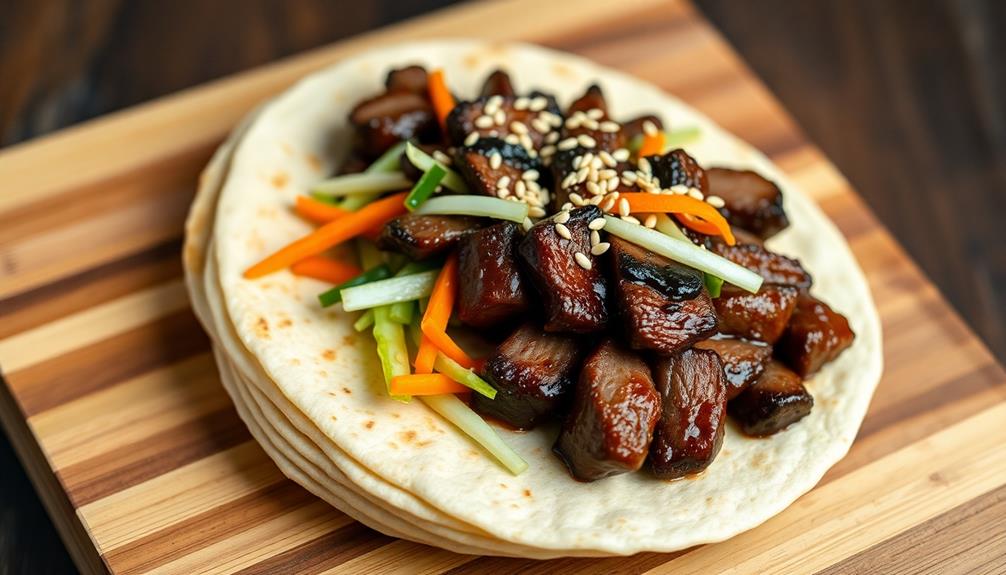
Take your warm, soft taco shells and layer them with the juicy, grilled bulgogi beef.
The savory, slightly sweet flavors of the marinated meat pair perfectly with the light and airy texture of the taco shells.
Sprinkle on some fresh, crisp cabbage for a satisfying crunch, and don't forget the tangy, creamy sour cream to balance out the dish.
Top it all off with a sprinkle of toasted sesame seeds for a nutty finish.
Wrap your hands around the taco and take a big bite, letting the flavors explode in your mouth.
The tender beef, crunchy cabbage, and cool sour cream create a medley of textures that will have you coming back for more.
These bulgogi tacos are a delightful fusion of Korean and Mexican cuisines, perfect for a fun and flavorful meal.
Step 5. Garnish With Fresh Cilantro

Top the tacos with a sprinkle of fresh cilantro. This fragrant herb will add a bright, zesty flavor that perfectly complements the savory bulgogi beef.
Gently pinch the cilantro leaves between your fingers and scatter them evenly over the assembled tacos. The green flecks will make your creation look extra vibrant and appetizing.
As you take your first bite, you'll get a wonderful mix of textures – the tender, marinated beef, the crisp taco shell, and the soft crunch of the cilantro. The cilantro's distinctive taste will dance on your tongue, cutting through the richness of the meat. It's a match made in taco heaven!
Garnishing with fresh herbs is an easy way to elevate any dish. Cilantro is especially perfect for these bulgogi tacos, adding a refreshing touch that balances the bold Korean flavors.
Go ahead and sprinkle it on generously – the more the merrier when it comes to this zesty green goodness!
Final Thoughts
As you wrap up your culinary adventure with these delectable bulgogi tacos, let's take a moment to reflect on the journey.
Wasn't it just amazing how the savory, tender bulgogi meat blended so perfectly with the crunchy, fresh vegetables and zesty sauce? The flavors danced on your tongue, creating a symphony of deliciousness that truly satisfied your cravings.
Now, as you savor the final bites, you can't help but feel a sense of accomplishment.
You've mastered the art of Korean-Mexican fusion, crafting a dish that's both authentic and innovative. The vibrant colors, the enticing aromas, and the satisfying textures all come together to make these bulgogi tacos a true culinary triumph.
As you lick the last bits of sauce from your fingers, you can't wait to share this recipe with your friends and family, introducing them to the amazing world of Korean-inspired street food.
These bulgogi tacos are sure to become a new favorite, leaving your taste buds craving more of this delightful fusion.
Frequently Asked Questions
What Is the Best Way to Store Leftover Bulgogi?
To store leftover bulgogi, place it in an airtight container and refrigerate it for up to 3-4 days. You can also freeze it for longer storage, but be sure to thaw it before reheating.
Can I Substitute Beef for Pork in This Recipe?
You can certainly substitute pork for beef in this recipe. The pork will have a slightly different flavor, but it will still work well with the traditional Korean seasonings and taco toppings. Feel free to experiment with the protein.
How Do I Reheat the Bulgogi Without Making It Dry?
To reheat the bulgogi without making it dry, you can try steaming it or gently warming it in a skillet with a splash of water or broth. This will help keep the meat moist and flavorful.
Can I Make the Taco Shells From Scratch?
You can absolutely make the taco shells from scratch! It's a simple process that allows you to customize the flavors and textures to your liking. Give it a try for a truly homemade taco experience.
How Long Will the Bulgogi Stay Fresh in the Fridge?
Your homemade bulgogi will stay fresh in the fridge for 3-4 days if you store it properly in an airtight container. Be sure to let it cool completely before refrigerating to prevent bacterial growth.
